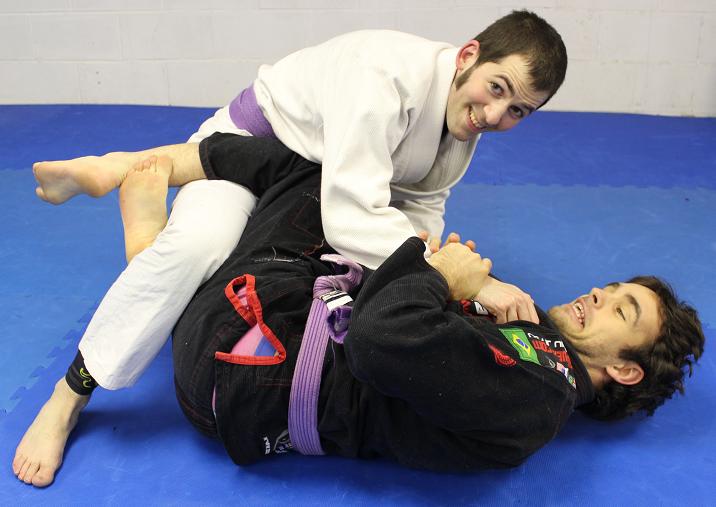RGA Aylesbury, (BJJ), Kev Capel, Aylesbury, Buckinghamshire, UK - 28/02/2015
Just a short one this visit, as my brother-in-law's flight getting delayed in the US, combined with a mortgage call they were dealing with, meant that the birthday plans for my younger niece got moved around. Rather than being able to train until 2pm, that meant I was needed back home for 12:00. Fortunately I'd already booked a private lesson, so could still get in about an hour of valuable training with Kev.
For this twentieth private lesson, I wanted to continue refining a path Kev had sent me down with an earlier private back in November 2013. I have always liked the tripod and sickle sweep combination from open guard, resulting in my open guard being built around those sweeps. My starting position was initially just sitting up with a stiff arm, based on Kev's lesson.
I've since been able to refine that, after buying Ryan Hall's Defensive Guard during a Black Friday sale. For me (and my friend Seymour agrees) it is easily Hall's best DVD set, which is saying something as his instructional sets are among the best on the market. I drilled my way through the DVDs with Chris last year and it's had a significant impact on how I approach seated guard.
Armed with the stuff I've learned from the DVDs, drilling with Chris and what I've been doing during open guard sparring, I ran through it with Kev. He suggested a few tweaks, plus some helpful additions for scenarios I haven't had much of an answer for (especially when they come in close to your shin). As a result, I've now got a coherent plan of action from open guard, based around that sitting guard position. As I'm finishing this write up on the 9th March a day after the GrappleThon, I've got details from rolling at that too (you can still support Equality Now and donate, here).
* Sit up, base an arm behind, grab their opposite collar. Keep a strong line through your shoulders and expand your chest, like Ryan Hall shows.
* Keep the foot of my raised knee outside theirs. If that knee starts to angle inwards, they can crush it down and pass, similar to the principle with knee shield passing.
* If they move to the outside of my raised knee foot, go for a collar drag and take the back. Remember to scoot around their near leg as you do.
* If they move to the inside, look for the loop choke, bringing your outside leg over their back as well. You'll tend to end up with the other knee pressing into their stomach, to clamp them in place as you go for the choke. Also, be sure to get the grip and pull down, rather than just flailing. I'm still tending to snatch at this choke rather than securing it properly, something I want to focus on.
* If they stay in the middle and with their head up, especially if they start to move backwards, ankle pick sweep them.
* If they come in close and they're standing, put your foot on their hip and move into the tripod/sickle combination.
 * If they come in close and start to sit with their knee on the ground, shift into shin-on-shin guard. I've never used this, but basically, just put your shin in front of their same side leg. With your other leg, push on their knee. That will normally make them post their arm. Grab their sleeve, then simultaneously pull on their sleeve and lift their shin for the sweep. Even better, pass their arm under their leg to your other hand. With your passing hand, grab around the back of their gi, then in combination with your shin lift, sweep them. It's much the same as the basic de la Riva sweep I was taught at GB Brum.
* If they come in close and start to sit with their knee on the ground, shift into shin-on-shin guard. I've never used this, but basically, just put your shin in front of their same side leg. With your other leg, push on their knee. That will normally make them post their arm. Grab their sleeve, then simultaneously pull on their sleeve and lift their shin for the sweep. Even better, pass their arm under their leg to your other hand. With your passing hand, grab around the back of their gi, then in combination with your shin lift, sweep them. It's much the same as the basic de la Riva sweep I was taught at GB Brum.* If you try the shin-on-shin sweep but they put their arm out of range, continue reaching for that arm. Make them think you are going for that, then switch your legs so you are hooking their rear leg with your forward leg. Grab the side of their knee and drive forwards, a bit like an ankle grab sweep.
* If they stand up from the shin-on-shin, move into single leg x and double ankle grab sweep. That one I'll need to review, as I don't think I quite got it. From what I remember, you lift up with your shin, pull their leg around (almost as if you're pulling mount), bringing your other knee behind their leg, just above their knee. You're still holding the foot (and collar, ideally I think), so can lift your hips and drive forwards to knock them over.
Interestingly, Kev said he's moved away from the nappy grip he showed me back in 2013, as it isn't high percentage enough when you're up against somebody who gets wise to it. Nevertheless, it's still a useful last resort: I haven't generally had a lot of success with it myself, though it worked pretty well last time I was in Bucks last November. I also got it a few times at the GrappleThon, although that was mostly during the long flow roll with Mike, so he wasn't putting up much resistance.
_____________
As always, visiting my parents meant art, this time the day after training. My father took me along to the Rubens exhibition at the Royal Academy, which is titled 'Rubens and His Legacy'. I have to agree with some of the critics who reviewed the show. While I don't think it's fair to complain that there isn't much Rubens, given that "and his legacy" is part of the description, there is an issue with a number of the comparisons. An exhibition based around a work's influence on both contemporaneous and later artists is something I could enjoy, but it quickly becomes frustrating if the original influences being discussed aren't there in some form.
That was a recurring problem here. Often, the text would say "and the influence of blah blah painting by Rubens can be seen in the blah', but that original painting would simply be referred to by its name and date. Even if there was some small monochrome reproduction, that would have been something, but nothing at all means the comparison is meaningless (unless of course you already know the paintings in question well, so my father didn't mind). Sometimes there was a copy of the original painting, which was better than nothing but still disappointing. The rather sparse audioguide didn't help.
 I can understand it's not always easy to get hold of paintings, but I think the exhibition would have been greatly improved if they focused on the paintings they could get and build it around that. So although there were lots of excellent paintings, it felt like I had walked into the middle of a film and missed the start. Having said that, splitting it into themes (e.g., 'compassion' for his religious art, 'lust', 'violence', etc) was a good idea, showing the range of Rubens work. The 'violence' paintings were particularly good, my favourite being 'The Fall of the Damned' (at least I think that was in the 'violence' room. Either way, it was cool). Sadly the original wasn't there (though the replacement they found at least gave a good idea), but with the magic of the internet I can reproduce Rubens' painting here.
I can understand it's not always easy to get hold of paintings, but I think the exhibition would have been greatly improved if they focused on the paintings they could get and build it around that. So although there were lots of excellent paintings, it felt like I had walked into the middle of a film and missed the start. Having said that, splitting it into themes (e.g., 'compassion' for his religious art, 'lust', 'violence', etc) was a good idea, showing the range of Rubens work. The 'violence' paintings were particularly good, my favourite being 'The Fall of the Damned' (at least I think that was in the 'violence' room. Either way, it was cool). Sadly the original wasn't there (though the replacement they found at least gave a good idea), but with the magic of the internet I can reproduce Rubens' painting here. 















